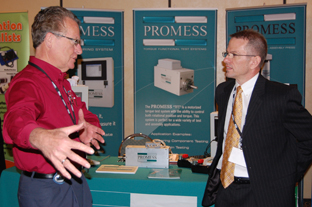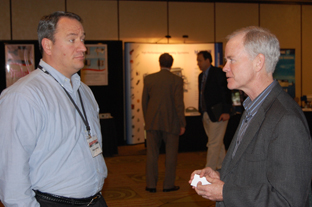

Larry Stockline (left), president of Promess Inc., discusses his company’s equipment with Steve Thomas, a senior project engineer with Delphi Corp. One of the speakers at the Summit, Thomas showed engineers how to make the most of flexible, robotic assembly cells.
Held March 24-26, the program featured senior engineers and upper-level managers from some of the country’s top manufacturers, including representatives from three of the first five winners of ASSEMBLY magazine’s Assembly Plant of the Year award: Lear Corp., IBM Corp. and Xerox Corp.
Besides a 12-hour didactic program, the Summit also featured exhibits from a variety of suppliers of assembly technology: Amatrol, Avdel, Automation Tool Co., Balluff Inc., BalTec, Bosch-Rexroth Corp., Design Tool Inc., Edgewater Automation, EFD Inc., Herrmann Ultrasonics Inc., Kawasaki Robotics Inc., KM USA, Mikron Assembly Technology, Promess Inc., Schunk Inc., Sortimat, Tridak and Weiss North America Inc.
Some 50 manufacturing engineers and managers from a wide range of industries attended the Summit. Represented in the audience were such companies as AGCO Corp., Austin Star Detonator, Bison Gear, Danfoss Drives, Deere & Co., Ethicon, Gentex Corp., Harley-Davidson, Kalmar Industries, Komatsu America, Life Fitness, the Lee Co., Lord Corp., Moog Inc., Motorola, Navistar and Nu-Way Electronics.

Mike Lawson (left), business development manager with ATC Automation Tool Corp., talks shop with automotive industry guru John McElroy. The owner and host of the television program Autoline Detroit, McElroy gave a candid presentation on the global future of the U.S. automotive industry.
Speakers Relate Innovative Practices
Leading off the program was Bruce Schullo, site quality manager for contract manufacturer Plexus Corp., who discussed his company’s quality practices. “When you’re a contract manufacturer, it’s very easy to fall into the trap of trying to assemble products the way everyone else wants you to,” he said. “Instead, you need to establish your own manufacturing and quality processes and stick with them throughout the entire organization.”Duk Kim, plant manager at Lear Corp.’s assembly facility in Montgomery, AL, discussed some of the innovative practices that helped his company earn ASSEMBLY magazine’s 2006 Assembly Plant of the Year award. For example, hourly workers receive bonus pay based on well they meet targets for safety, quality, delivery, cost and attendance. Before hiring on at the facility, potential employees participate in a simulated assembly line to see if they can cope with the pressure and physical stress of high-volume automotive assembly.
A particularly innovative use of technology emerged from a presentation by Tim J. Shinbara Jr., a manufacturing engineer with Northrop Grumman Corp. Shinbara related how his company uses radio frequency identification technology to keep track of time-sensitive adhesives for aerospace assemblies. To extend their shelf-life, the adhesives are stored in a freezer. Each container of adhesive carries an RFID tag, which is read whenever the container goes in or out of the freezer. In this way, Northrop always knows how much adhesive it has and how close each batch is to its expiration date. In addition, the adhesive supplier-which manages the freezers for the aerospace company-is automatically notified whenever supplies get low.
Daniel E. Banaszak, plant manager of Xerox’s assembly facility in Rochester, NY, discussed how his company handles high-mix assembly through a process of standardization and delayed differentiation. One line turns out certain copiers in a base model, which is then configured to customer specification at the last minute. However, for delayed differentiation to work, certain components had to be standardized. For example, in the past, the wire harnesses for various copier models had different connectors. By standardizing the connectors, Xerox could install some wiring early in the assembly process, regardless of what options the copier would eventually have. “By the way, standardizing the connectors also lowered the cost of the wire harnesses, since the contract manufacturer can now make them at higher volumes,” said Banaszak.

Some 50 manufacturing engineers and managers from a wide range of industries attended the inaugural Assembly Summit.
Tour of S&C Electric Lends Spark to Summit
A highlight of the Summit was a tour of S&C Electric Co.’s sprawling manufacturing complex on the North Side of Chicago. Walking through the company’s 50-acre campus, engineers saw firsthand how this assembler of fuses, switches and electrical distribution equipment applied lean manufacturing principles to create one-piece-flow assembly lines.A good example is the assembly line for the company’s Vista series of underground electrical distribution centers. These hermetically sealed stainless steel boxes-the largest is the size of a refrigerator-are packed with high-voltage fuses and switch gear. In the past, assembling these products was very much a batch-and-queue operation, if for no other reason than because the assemblies were transferred from one station to the next via an overhead gantry. After a kaizen event, the company redesigned the line, arranging fabrication, assembly and test equipment in close proximity to create one-piece flow. Instead of relying on the gantry, the assemblies are moved from station to station primarily on a heavy-duty, floor-level roller conveyor.
Throughout the tour, engineers saw technology at work, including presses, radial forming machines, automatic wire processing machines, automatic dispensing equipment, automatic test equipment, tabletop soldering robots, welding cells equipped with heavy-duty six-axis robots, state-of-the-art CNC machining centers with automatic tool changers, and a variety of fabrication equipment, including a high-power laser for cutting stainless steel sheets.
Continuous improvement is a mantra at this employee-owned company, which was founded in 1911. Indeed, the company is on pace to complete 75 to 100 kaizen events for 2009 alone.
Another example of the company’s commitment to continuous improvement can be seen in “Opportunity Boards” are scattered throughout the factory. Employees are invited to write problems or improvement opportunities on index cards and post them to the board. Any employee can review the postings and initiate action to solve the problem or implement the suggestion. For example, one card called for extra safeguarding around a machine.
The board is divided into three sections: one for new suggestions, one for suggestions in the process of being implemented, and the last for suggestions that have been fully implemented. To encourage participation, every employee who posts an improvement opportunity on the board is rewarded with two “S&C Bucks”-virtual money that can be redeemed like cash at the company cafeteria or clothing shop.
Recent Comments
Helpful for Trainees
Cable Assembly Manufacturers
Huawei for manufacturing?
should have a scanner and then 3D print the repair
IPC-A-610 and IPC-j-std-001